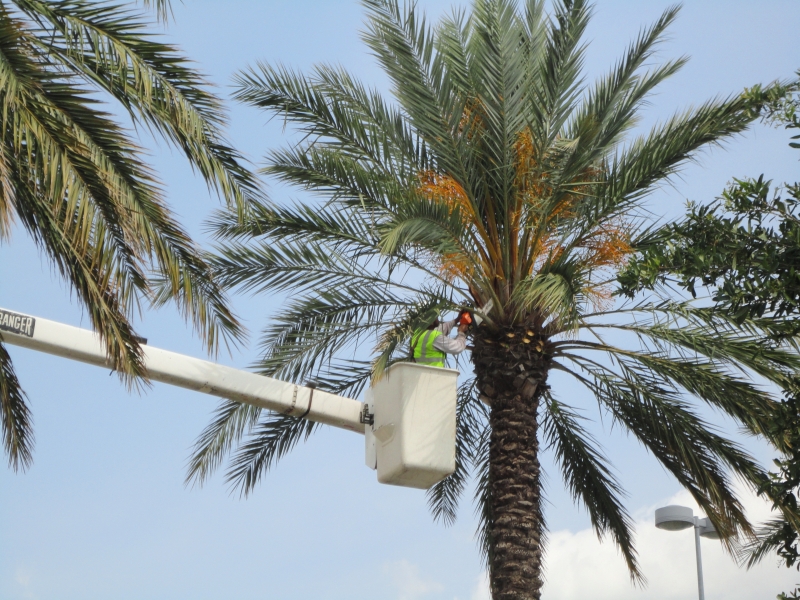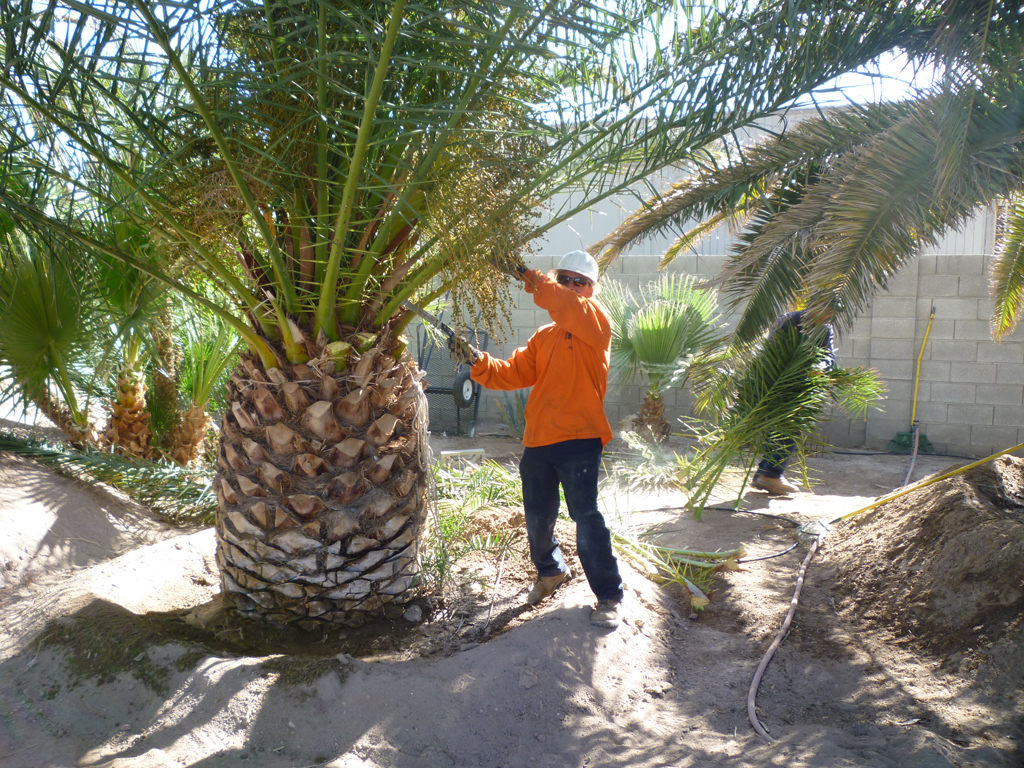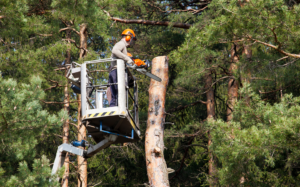Trimming a palm tree trunk is an important part of maintaining the health and appearance of your palm trees. While many people focus on trimming the fronds, cleaning up the trunk is equally important for aesthetic reasons and to prevent pest infestations. Palm tree trunks can accumulate old frond bases, dead material, and even pests, which can affect the tree’s overall health. Properly trimming the trunk not only enhances the tree’s appearance but also promotes better air circulation and reduces the risk of disease. This guide provides a detailed step-by-step approach to trimming a palm tree trunk, the best time to do so, the cost of professional services, and the necessary equipment required. We’ll also cover some unique aspects of palm tree trunk care to help you keep your tree in optimal condition.
Step-by-Step Guide to Trimming a Palm Tree Trunk
Trimming a palm tree trunk requires careful attention to avoid damaging the tree. Here’s how to trim a palm tree trunk effectively:
- Assess the Trunk:
- Begin by examining the trunk for dead frond bases, loose bark, or signs of pests like insects or mold.
- Identify areas where old fronds are attached or where there is excessive debris.
- Gather the Proper Tools:
- Use a pruning knife or a serrated knife for small frond bases and loose bark. For thicker bases, a hand saw or pruning saw may be required.
- For tall palms, a ladder or a pole saw with an adjustable head can help reach higher sections.
- Remove Dead Frond Bases:
- Start from the bottom and work your way up, gently cutting away dead frond bases that are no longer firmly attached.
- Avoid cutting into the living tissue of the trunk, as this can create wounds that invite pests and disease.
- Peel Off Loose Bark:
- Use your hands or a knife to peel off loose, hanging bark pieces to clean up the trunk’s appearance.
- Be careful not to strip the trunk too aggressively, as this can damage the living tissue underneath.
- Trim Pest-Infested or Moldy Areas:
- If you notice any areas with pests or mold, trim these sections carefully and consider treating the trunk with a pesticide or fungicide to prevent further issues.
- Shape the Trunk:
- For a uniform appearance, you can trim the frond bases to create a smoother look along the trunk.
- This step is purely aesthetic and should be done cautiously to avoid unnecessary harm to the tree.
- Inspect and Make Final Adjustments:
- Step back and inspect the trunk from a distance. Ensure all dead material is removed and that the trunk has a clean, uniform appearance.
- Make any additional small cuts as necessary to perfect the trunk’s look.
- Clean Up Debris:
- Clear away all trimmings from around the base of the tree to prevent pest attraction and maintain a tidy landscape.

Best Time to Trim a Palm Tree Trunk
Timing is crucial when trimming a palm tree trunk to minimize stress and promote health. Here’s the best timing for trimming:
- Late Spring to Early Summer:
- This is the ideal time to trim the trunk because the palm is actively growing and can quickly recover from the trimming.
- Trimming during this time also prepares the palm for storm season by removing dead material that could become hazardous in high winds.
- Avoid Trimming During Cold Weather:
- Trimming during colder months can stress the tree, particularly if the palm species is sensitive to cold.
- Trim Only When Necessary:
- Palm tree trunks do not require frequent trimming. Clean up the trunk when there is a buildup of dead fronds, bark, or signs of pest infestations, typically once a year.

Cost of Professional Palm Tree Trunk Trimming
Hiring a professional to trim a palm tree trunk can vary in cost depending on the size of the tree, the extent of trimming needed, and accessibility. Below is a general cost guide:
| Service | Average Cost | Factors Influencing Cost |
|---|---|---|
| Small Palm Trunk (under 10 feet) | $50 – $100 | Accessibility, amount of dead material to remove |
| Medium Palm Trunk (10 – 20 feet) | $100 – $200 | Tree health, complexity of cleaning required |
| Large Palm Trunk (over 20 feet) | $200 – $500 | Use of specialized equipment, height, and proximity to structures |
| Extra Services (e.g., pest control, trunk treatment) | $50 – $150 per service | Specific needs related to tree health |
- Factors Affecting Cost:
- Tree Height and Accessibility: Taller trees or those located near obstacles will require more labor and equipment, increasing costs.
- Tree Health: If the tree has pest issues or disease, additional treatments may be necessary, adding to the overall cost.
- Location: Palms in difficult-to-reach areas or those requiring specialized equipment (like a bucket truck) will have higher costs.
- Debris Removal: Some companies charge extra for debris removal, particularly if a large amount of dead material is removed.
Equipment Required for Trimming a Palm Tree Trunk
Using the right tools ensures the trimming process is efficient and safe. Below is a list of recommended equipment:
- Pruning Knife: For small frond bases and loose bark, ensuring precise cuts without damaging the trunk.
- Hand Saw or Pruning Saw: For thicker frond bases or larger palms, providing the strength needed to cut through tougher material.
- Pole Saw: Useful for reaching higher parts of the trunk without climbing a ladder, especially for taller palms.
- Ladder: A stable ladder, ideally a tripod ladder for better stability, is essential for accessing higher parts safely.
- Safety Gear: Gloves to protect your hands from sharp fronds and rough bark, safety glasses to prevent debris from entering your eyes, and a hard hat for protection from falling debris.
- Disinfectant: To clean tools between cuts, particularly when dealing with pest-infested or diseased sections, to prevent spreading pathogens.
Additional Details Specific to Palm Tree Trunks
- Nutrient Uptake: Unlike other trees, palms rely heavily on their fronds and trunk for nutrient uptake. Avoid removing green fronds or cutting into live tissue as this can disrupt the tree’s nutrient flow and overall health.
- Pest Prevention: Trimming the trunk regularly helps prevent pests such as palm weevils, borers, and scales. Dead material can harbor pests, so keeping the trunk clean is essential.
- Avoid Over-Trimming: Excessive trimming of the trunk can lead to “skinny trunk syndrome,” where the trunk becomes weak and susceptible to breaking. Trim only dead and loose material, and avoid cutting into the trunk itself.
- Structural Integrity: The trunk is crucial for the palm’s structural integrity. Any damage to the trunk can compromise the tree’s stability, making it vulnerable to strong winds or storms.
Conclusion
Trimming a palm tree trunk is an essential maintenance task that not only enhances the appearance of the tree but also supports its health by removing dead material and preventing pest infestations. By following the proper trimming techniques and timing, you can ensure your palm tree trunk remains clean, strong, and attractive. Whether you decide to tackle the trimming yourself or hire a professional, it’s important to use the correct tools and methods to avoid harming the tree. Regular inspection and careful maintenance will keep your palm tree healthy and vibrant, making it a stunning focal point in your landscape. Understanding the specific needs of palm tree trunks, such as their role in nutrient uptake and the importance of preserving the trunk’s integrity, will guide you in providing the best care for these unique and beautiful trees.


